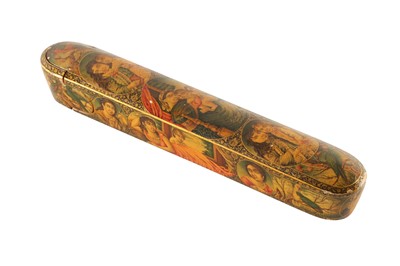28th Oct, 2022 11:00
Islamic Art - Property of a European Collector Part IV
A LACQUERED PAPIER-MÂCHÉ PEN CASE (QALAMDAN) WITH WESTERNISED MOTHER AND CHILD SCENES
Qajar Iran, dated 1325 AH (1907) and signed Abd al-Husain Sani' Humayun
A LACQUERED PAPIER-MÂCHÉ PEN CASE (QALAMDAN) WITH WESTERNISED MOTHER AND CHILD SCENES
Qajar Iran, dated 1325 AH (1907) and signed Abd al-Husain Sani' Humayun
With rounded ends and a sliding tray, polychrome-painted, heightened in gold, and lacquered, the decoration on the top arranged in vertical order and on the sides in horizontal order, the top featuring three oval medallions filled with a European Old-Master painting-inspired Mother and Child scene in the centre and two brother and sister portraits above and below it, on each end a realistic parrot perched on a bare branch, the central medallion inscribed amal-i Abd al-Husain Sani' Humayun 1325 in gold, the sides featuring more medallions filled with Westernised female tronies wearing pearl chokers and nudes, two ladies holding grape bunches, interspersed amidst natural scenes with pairs of parrots and birds on tree branches, the underside of the case and inner sides of the sliding tray enhanced with floral scrollwork with lotus flowers, rosettes, and serrated leaves in gold on a black ground, 23cm long.
In the Khalili Collection of Islamic Art, there are three pen cases signed by the same lacquer master and dated around the same time (one with exactly the same date) as our lot. The link seems, thus, undeniable. According to Muhammad Ali Karimzadeh Tabrizi, the Isfahan-born Abd al-Husain Sani' Humayun (1276 - 1340 AH) was the son of the lacquer painter Aqa Muhammad Kazim and the grandson of Aqa Najaf. He also believes he was appointed the title 'Sani' Humayun' (imperial craftsman) by Muzaffar al-Din Shah, who ruled between 1896 - 1907. However, some of his earlier works are already signed with his full title, leading to suggest that the appointment happened under Nasir al-Din Shah's reign instead. As it is often the case with many Isfahani lacquer artists organised in circles and ateliers, his work was replicated by his pupils, who used his signature as tribute. That said, their works are usually easy to spot since they lack the genius and finesse of their master's hand.
The work of Abd al-Husain can be compared to several productions of another Qajar artist, Muhammad Baqir Samirumi. In fact, both painters used oils rather than watercolours and the subsidiary illumination on their works was produced by the same artist, Muhammad Ali Muzahhib. The quintessential features characterising this qalamdan as a creation by Abd al-Husain include the presence of studies of pairs of parrots on each end of the pen case; three-quarter-length portraits of women in European dresses with several pleats; and a reclined Westernised lady with a child on the side. For further comparisons and examples attributed to this artist, please see Nasser D. Khalili, B.W. Robinson, and Tim Stanley, Lacquer of the Islamic Lands: Part Two, 1997, p. 242, cats. 472, 473, and 474.
Sold for £2,000
Includes Buyer's Premium
Do you have an item similar to the item above? If so please click the link below to submit a free online valuation request through our website.





